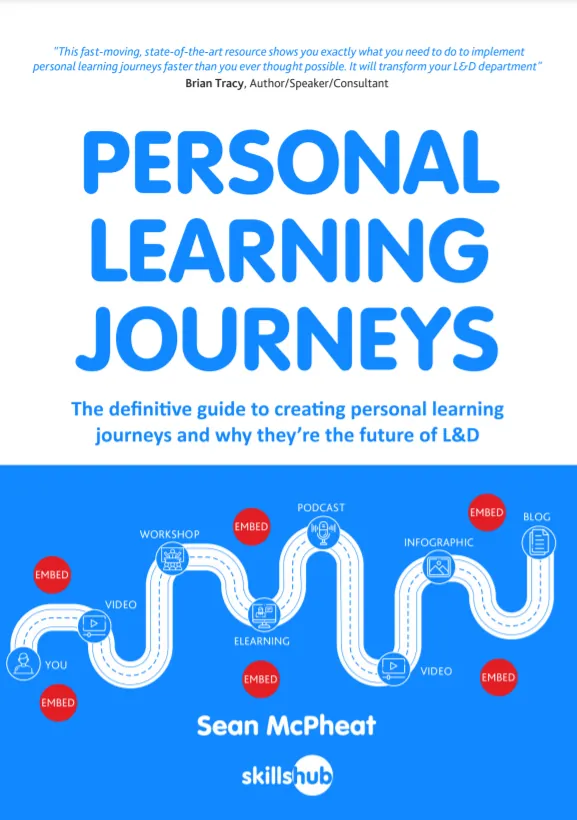
It is becoming increasingly important for organisations to encourage continuous improvement and learning throughout their entire enterprise. These days, potential employees seek outprogressive places to work, which comes down to the culture of your organisation and a learning culture in particular.
There’s a growing and significant trend towards continuous professional development (CPD). Always a part of the requirement of some professions (eg the law and medicine), CPD and continuous learning is now a popular strategy in many top companies. The benefits of continuous development are backed up by data too:
- 94% of employees admit they’d remain longer at a company which invests in their professional development. [source: LinkedIn]
- 86% of employees say it’s important for employers to prioritise their learning opportunities [source: Ceridian]
- Almost half (46%) of survey respondents say they are bored at work due to a lack of learning and development opportunities [Source: Udemy]
The statistics above are without even considering how having employees learning new skills can benefit the bottom line. What then, is the secret to creating a work environment and a workforce that are focused on continually learning and growing? This lies in the development of a continuous learning culture.

What is the Learning Culture Definition?
Put simply, this is an environment in which continuous learning and improvement is provided, welcomed, and eagerly participated in. Companies who merely pay lip service to mandatory, one-size-fits-all training produce employees who grow to resent training, because they can’t see its relevance. It doesn’t meet their training needs.
However, where training and development does benefit employees, by helping them gain valuable skills or perform their roles with greater ease, it is generally welcomed. A culture of learning is predicated upon three things: appropriate training, willing employees, and compliant managers.
In a continuous learning culture, training and educational programs are built-in to work schedules, rather than being shoehorned into an already busy calendar. Employees who are on training programs do not leave their colleagues in the lurch with unbearable workloads. Instead, the whole environment is built around regular upskilling.
Research firm CEB (part of the Gartner group) gives this apt definition for Learning Culture (as reported in HBR):
“a culture that supports an open mindset, an independent quest for knowledge, and shared learning directed toward the mission and goals of the organisation.”
The important components of a continuous learning culture, therefore, include:
- Open mindset – employees are willing to learn new skills and abilities.
- Independent quest for knowledge – employees’ learning is self-motivated and does not require constant supervision.
- Shared learning – nevertheless, employees can share what they learn.
- Fit to organisational goals and mission – learning is relevant and profitable.

Learn How To Create Personal Learning Journeys For FREE!
Why is a Learning Culture Important?
In 2022, we are all learning, all the time. The growth of elearning platforms like Skillshub and Masterclass make this clear, as does the common tendency to “Google” something, rather than call in an expert, or to consult a YouTube video to fix something simple around the house ourselves. We’re all used to being self-motivated and continual learners.
Why then, should the workplace be any different?
The second important reason to instil a learning culture in your workplace is that the pace of technological change is accelerating in the 21st century. According to a 2021 report by Productiv, the average company uses 254 SaaS apps, although on a day-to-day basis only 45% are in regular use (at least once in 60 days). Although few employees will be required to master more than a handful of these, this still represents a huge challenge to employers trying to onboard new staff as quickly as possible.
As well as new software and systems, there are whole new industries and technologies popping up (blockchain, AI, cloud computing) which are revolutionising business. The pace of social change is accelerating too, with new DEI programs being developed and environmental awareness, social inclusion and social justice becoming more critical to the success of businesses which, in an earlier era, might have remained politically neutral.
With all this newness and change, it means that employers must build in time to cope with new movements and technologies. It benefits employees to widen their skillsets, particularly in a changing work environment with greater reliance on remote and hybrid working. The 21st century employee is a self-starter, able to pick up new skills eagerly and quickly.
For all of the above to be possible, employers must be on board with facilitating a culture of learning.

21 Top Tips to Create a Learning Culture
Companies can build a culture of learning in a number of different ways. Below we present 21 tips for doing so, as smoothly and painlessly as possible.
1: Promote Knowledge Sharing
Create LMS systems and opportunities for people to share their individual skills and knowledge. Whether it’s by hosting weekly skill-sharing sessions, or by the use of an online learning platform to post helpful documents and summaries, there are a range of ways to promote the sharing of information.
2: Audit your Skill Gaps
Rather than using educated guesswork, why not survey the current state of knowledge within your workforce, so that you can readily identify skill gaps. You’ll then be able to better target resources, time, and systems towards filling those gaps.
3: Go Modular
A lot of the frustration employees experience with training programs is how irrelevant many of them seem. Historically, training took place in groups where programs had to be designed to cover a wide pool of existing skills and knowledge. Now, however, with learning moving online, it ought to be possible to render programs far more specific and focused especially through virtual training.
Why run through the history of computer programming and software development, when what you really need to know is how to go about building an app? Creating topic-specific modules rather than broad-based programs will also help keep training aligned with corporate priorities.
4: Align Learning with Leadership
Leadership training can be tied to achieving learning thresholds in a way that benefits executives and departments alike. Tying advancement to learning is a great way of motivating continuous professional development – it’s a carrot rather than a stick.
5: Engage Managers and Supervisors
Rather than making managers feel disadvantaged by having employees removed from the workplace to engage in learning, find ways to involve managers directly in the commissioning of training and development opportunities. Motivate managers to create spaces for knowledge sharing or positively incentivize their employees to attend. Of course, listening to what managers say their staff need is key to bringing them on board.
6: Reward Engagement
In an ideal world, learning for learning’s sake is reward in itself, but in the 21st century, it can’t hurt to offer other incentives for engagement! Attendees (virtual or otherwise) on training programs always welcome certificates, badges, and public recognition for the completion of demanding programs.
In our social media obsessed culture, such small progress indicators can have remarkable effects, even engendering a spirit of friendly competitiveness.
7: Use Online Platforms
Face-to-face training can be fun and in some cases is essential (e.g. first aid courses), however, for most individual learning, online learning platforms can be a godsend. Not only do they allow employees to dip in and out of training courses in the office, but they can often be accessed remotely, to ensure that no member of staff misses out.
8: Keep it Short and Simple
There’s little as off-putting in a piece of coursework as thick reams of text and paragraphs that seem to never end.
Break up your insights with illustrations, photographs, and diagrams. Further divide the course into mini-modules that can be completed in a matter of minutes. This allows even those who are highly time-constrained to make meaningful progress. Being able to pause and come back to a topic later takes some of the pressure off.
9: Encourage Innovation and Experimentation
An environment where risk-takers are rewarded, and new ideas are welcome is usually more conducive to meaningful learning than one in which change is avoided. Encourage everyone to keep up to date with new systems and radical developments. Learning about new developments can be a lot of fun and can keep your organisation ahead of the curve.
10: Enlist Sector and Subject Matter Experts
Alongside using off-the-shelf content and general programs, you should also make sure that some of your training is devised and run by sector experts. These could be in-house personnel if the skillsets are there. It’s much easier to learn from someone who clearly knows what they are talking about and loves the subject matter.
This is an obvious point we all recognise from school days – we recall that one inspirational teacher who radiated passion for a topic and made us want to discover what all the fuss was about. Where possible, bespoke tailor your learning accordingly.
11: Learning is a Two-Way Process
Make sure the learning activities are interactive, with participants responding to their teachers, and teachers requiring a degree of interaction. Voicing an idea, thought or understanding will always help to make it “stick”.
Provide feedback to course leaders on how well they are doing and ensure this is anonymized so that participants feel free to comment honestly. Too many intrinsically interesting subjects can be rendered dull and flat by under-enthused teachers.
12: Gamify the Lessons
As well as the rewards and public incentives mentioned above, using quizzes at the end of modules, or at the midway point can help instil key takeaways while gamifying the process of learning. Make sure these quizzes are not too difficult and that participants can go back and revise things they have forgotten, then try again.
After all – it’s not actually about the quiz, but about making sure that key points are remembered. Learning that fades away as you read isn’t learning at all.
13: Get Hands On
Any activities which can incorporate an in-person activity or project really should. Engaging the creativity, imagination and practical skills of participants is a great way of making the learning experience memorable. Any program teaching skilful use of a design platform, for instance, should cultivate in a small-scale design project, to be devised by participants.
14: Ensure Accessibility
To avoid leaving anyone out, make sure your venue or online platform is accessible to those with mobility issues or sensory impairments. The last thing you want to do is exclude anyone at your organisation and prevent their learning and development.
15: Give Participants Feedback
Another way to create a culture of learning is to give participants regular feedback on how they are doing. Even though this may not be delivered publicly, even an encouraging message or email can work wonders with engagement.
When an employee needs to work a little harder or spend more time on a specific area of learning, it’s better to be honest and address this sooner rather than later without singling them out. Putting off giving feedback can lead to colleagues racing ahead and your team ending up at different stages of your learning program. Subconsciously, what the presence of honest feedback says is “this process matters to us; it should to you, as well.”
16: Build a Resources Library
Appreciate that not everyone learns the same way. While some like to read, others like to work from instructional videos, podcasts, or in-person seminars. Start building an accessible resource library where every employee can supplement their understanding of the topic in a manner they enjoy and most benefit from.
17: Consider a Book Group
Particularly on the topics of innovation, R&D, and leadership, there are a great many inspirational books that apply to the business environment either explicitly or implicitly. Consider setting up an informal monthly book group and assigning a chapter of something for discussion.
18: Make it Social
Affiliated to the book group idea is any social learning session where participants are encouraged to mix and interact. After-work sessions presenting short topics for discussion followed by drinks may work very well for some industries. Consider it a pan-corporate networking session. At many company-wide training sessions employees may meet one another for the first time or continue building on existing working relationships.
19: Make it Ongoing for Everyone
Rather than seeing learning as something which has a concrete duration and an endpoint, begin to promote it as an ongoing process. Ensure that managers and executives engage as fully as each other.
Education, particularly on a cutting-edge topic, can prove a great leveller.
20: Measure and Adapt
Good training is never static – it evolves to suit both the environment and its participants’ needs. As much as possible, use metrics and KPIs to measure its effectiveness and the degree to which the learning points “stick” and that the transfer of learning back into the workplace has taken place. Methods such as the Kirkpatrick Evaluation Method can prove invaluable.
Once you’ve measured the success of your training, you can adapt and change learning methods and content accordingly.
21: Keep it Fun!
Here’s an often overlooked but important point to finish with.
Learning doesn’t need to be dry or mundane. It can be participatory, and even revelatory. Consider visits to parts of the company too few people see. If you’re working for a broadcaster, for instance, take your staff to climb a transmission tower (while learning about relevant broadcast technology, of course). There’s an equivalent immersive experience in every industry if you’re sufficiently creative.
Enlist the Right Partner to Deliver a Learning Culture
Of course, you’ll need help with all this and the right tools to implement it, and that’s where Skillshub comes in. We offer a variety of services and tools to help organisations create or build on existing learning cultures, whether you are in need of an online learning platform to host your content, or are looking to create bespoke learning materials to provide to your team. You can get in touch with the team to find out more about our offering.
As an eLearning company, Skillshub is committed to creating efficient and impactful learning experiences.
Why not check out our other articles on how to gain competitive advantage and deliver excellent training at our L&D Blog? You’ll also find my book, Personal Learning Journeys, insightful too. Get it here for free.













